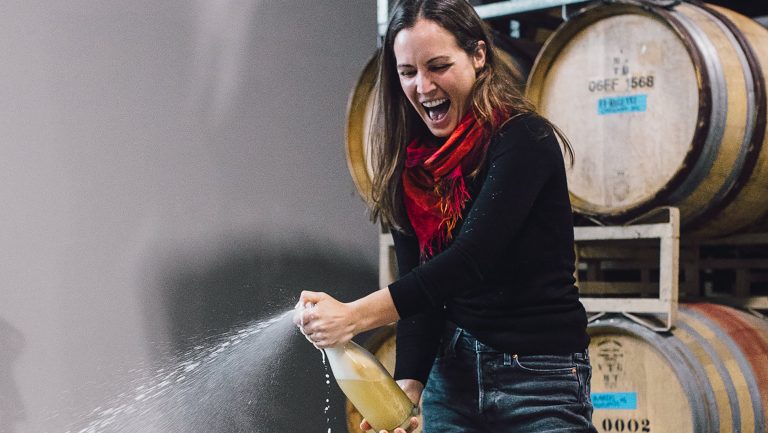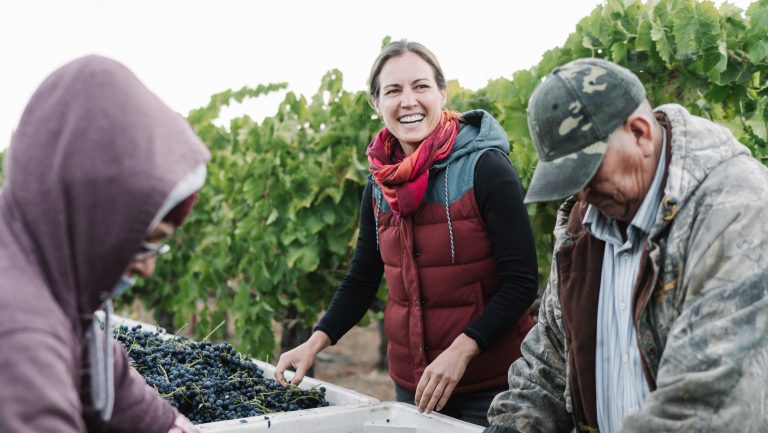Martha Stoumen is one of the few winemakers making Nero d’Avola in California. Production of the grape is minuscule in the state, a mere 100 of the 40 million tons of red grapes crushed there each year. But Stoumen had a vision for the grape. She had learned to make a light, vibrant style of Nero d’Avola at COS, in Sicily’s warm, dry climate. She wanted to prove that similarly fresh, featherweight wines could be made in Northern California, where extracted, higher-alcohol styles are often the norm.
“My goal is to make wines that are delicious and alive, and that will age gracefully,” says Stoumen. “I think Nero d’Avola made in California has the potential to produce beautifully aged wines.”
She has quickly gained a following for her Nero d’Avola—and the seven other wines she makes from underdog grapes like Carignan, Negroamaro, and Marsanne. Stoumen’s first solo vintage of 900 cases was released in 2017, and sold out rapidly. The 2018 vintage of 2,500 cases sold out even faster.
“Martha expresses the human spirit in her wines,” says Vinny Eng, wine director at Tartine in San Francisco. “When you taste Martha Stoumen wines, you can taste her expertise and the different vintages she’s worked with. They are bright and thoughtful and make you feel like you are in capable hands.”

Don’t miss the latest drinks industry news and insights. Sign up for our award-winning newsletters and get insider intel, resources, and trends delivered to your inbox every week.
Building a Strong Foundation
Stoumen has traversed an unconventional path in a male-dominated industry: as a farmer, grower, winemaker, and entrepreneur. “Being a woman does make things different,” she says. “I see women placed in the wine lab more often, and men being asked and taught how to operate machinery while women are not.”
The winemaking bug hit Stoumen when she was 21 years old, during a farm stay in Tuscany. “When I was in the vineyard, the cantina, and the olive orchard, I remember a poignant sense of feeling like a kid again,” she recalls. “The moments, as an adult, when you’re transported back to being a child are magical, so I had to listen up.” She listened, working harvests around the globe—from France to New Zealand—discovering that she favored natural winemaking techniques.
Stoumen went on to earn a Master of Science in Viticulture and Enology from UC Davis in 2012. From there, she completed a three-month internship at COS in Sicily, starting in the cellars. She had to make significant efforts to not be left behind. “Once I saw how I was being pigeonholed during my time in Sicily, I got up early one day and set up the crush pad on my own before the men got into work,” Stoumen says. She learned not to ask permission, but to simply show up, watch, and learn.
In 2014, she took a part-time role as COS’s brand ambassador in the US for two years. During her commercial relationship with COS, she was also an assistant winemaker at Broc Cellars until 2017, and made wine for herself on the side.

Choosing Nero d’Avola
In Sicily, Nero d’Avola is generally made into deep, dark wines with high alcohol. But producers like COS and Occhipinti, both in Vittoria, in the south of Sicily, buck that trend. The biodynamic viticulture and natural vinification techniques favored by these producers yield wines that are lighter, with vibrant acidity and lower alcohol levels.
Stoumen learned the ropes firsthand under the mentorship of Giusto Occhipinti of COS, and by spending time with Arianna Occhipinti of Occhipinti (Arianna is the niece of Giusto). “Our objectives as winemakers should be to express the land where your wines come from—elegance, personality, and depth emerge from worthy producers who have a keen sensibility towards place,” says Arianna Occhipinti.
In 2014, when Stoumen returned to California to work at Broc Cellars, she became convinced of California’s potential for lighter styles. The winery “was the sole torch reminding me of what California wine could be,” she says. “More than any specific technique, what I learned from Chris Brockway is that the wines I like to drink could be made in California.”
Finding Balance in the Field
These days, Stoumen leases and farms the vineyards she works with, or sources her fruit from ecologically-minded growers, on vineyards that are all north of San Francisco, from San Pablo Bay to Mendocino. The vineyards she manages are practicing organic, favoring dry farming with light soil plowing, and treatment as needed with sulfur.
Stoumen’s Nero d’Avola grapes are sourced from vineyards she farms in the Mendocino AVA and from growers in Ukiah Valley. Stoumen prizes these warmer, drier inland areas for their lower disease pressure and climatic similarities to Sicily’s Vittoria region, though the soils are denser and richer than at COS or Occhipinti. Stoumen says she compensates by watching the grape ripening process like a hawk and picking at the Goldilocks moment, right before the sugars get too high.
In the cellar her methods are straightforward, with minimal intervention, such as spot-adding low amounts of sulfur in select barrels, in order to give the best expression of the vineyard. All Nero d’Avola grapes are destemmed. “I don’t add anything prior to fermentation and the fermentation occurs with native yeast and in small vats,” she says. “I punch down the fermentations twice a day and press at dryness, which usually takes about two weeks to achieve.”
The result is a fresh expression of Nero d’Avola, with wild fruit, structured tannins, and distinct mineral nuances. Alcohol levels have come in surprisingly low, at 12.4% to 13.2% ABV, depending on the vintage. These wines deliver the elegance of a COS or an Occhipinti, but with a distinctly New World flair.
Her approach is technique-driven, prioritizing quality and terroir over trends. “Martha makes natural wines accessible, cuts out the scene-y mumbo-jumbo, and squashes any doubt for California’s capacity to make sophisticated natural wines,” says Angel Davis, co-owner of Fig & Thistle, a wine boutique and bar in San Francisco that sells and serves Stoumen’s wines.
Natural Next Steps
As she looks forward, Stoumen hopes to continue to experiment with Italian styles in California, fostering quality collaborations to further improve the region’s reputation for natural wines. She plans reds styled after those made in the volcanic Etna region, using Sicilian Nerello Mascalese and Nerello Cappuccio grapes, and whites using Carricante. She has already toyed with a blend of Nero d’Avola and Zinfandel, nicknamed Cali-Cerasuolo, and is curious to see how Frappato would do.
But Stoumen knows she can’t do it alone—and doesn’t believe in basking in solopreneur glory or playing the do-it-all Renaissance woman. In fact, she is seeking out winemakers to collaborate with. “I want California to continue producing better wines, and we don’t do that as islands; we need to share,” she contends. “I got into this industry because it made me feel like a kid, and no kid wants to play alone forever.”

Dispatch
Sign up for our award-winning newsletter
Don’t miss the latest drinks industry news and insights—delivered to your inbox every week.
Coral Sisk is a Florence-based writer, certified Italian sommelier, and culinary travel professional. She holds a degree in Italian Language & Literature with a focus on Food Studies from the University of Washington in Seattle. Her writing appears on sites like Eater, The Guardian, and Condé Nast, and is the creator of Curious Appetite Travel, a provider of bespoke gourmet wine experiences around Italy.







